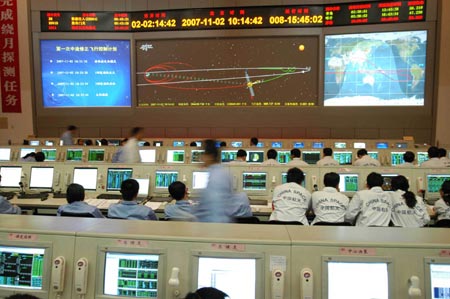
Experts work at the Beijing Aerospace Control Center
(BACC) in Beijing, capital of China, Nov. 2, 2007. China moon exploration team
successfully made the first orbital correction to the probe Friday morning to
ensure that it travels on the projected orbit. - Xinhua
China's first lunar probe, Chang'e 1, will reach the moon's orbit this
morning and currently, it was traveling on the expected trajectory, scientists
said yesterday.
Chang'e 1, following the instructions of the Beijing Aerospace Control Center
(BACC), will carry out its first braking at perilune at about 11:00am today to
slow down, so that it can be captured by the lunar gravity and become a
circumlunar satellite, said Wang Yejun, chief engineer of BACC.
"The speed of Chang'e 1 can reach 2.4 km per second when it arrives at
perilune, and it will likely fly away from the moon if the braking is not
conducted in time," Wang said.
"The first braking at perilune is another key moment in the long journey of
Chang'e 1," he said.
China's first lunar probe, Chang'e 1, named after a legendary Chinese goddess
who flew to the moon, blasted off on a Long March 3A carrier rocket on Oct. 24
from the Xichang Satellite Launch Center in southwestern Sichuan Province.
The probe completed its fourth orbital transfer late Wednesday afternoon,
shifting out of its 120,000-kilometer orbit around the Earth and moving toward a
380,000-kilometer circumlunar orbit.
BACC successfully carried out an orbital correction for Chang'e 1 Friday
morning to ensure that it travels on the pre-set orbit.
A second orbital correction scheduled for Sunday morning has been called off
because it was "unnecessary" -- Chang'e 1 has been running accurately on the
expected trajectory, a BACC scientist said.
"Currently, Chang'e 1 was traveling at a speed of more than 300meters per
second toward perilune, and all data show that the satellite is operating well,"
Tang Geshi, BACC scientist told Xinhua late yesterday afternoon.
"We're now studying how to ensure the success of the first braking for
Chang'e 1," he said.
After the probe entered the moon's orbit, it would brake several more times
to slow down, scientists have said.
It is scheduled to relay the first picture of the moon in late November and
would then continue scientific explorations of the moon for a year.
The 2,350-kg satellite carried eight probing facilities, including a stereo
camera and interferometer, an imager and gamma/x-ray spectrometer, a laser
altimeter, a microwave detector, a high energy solar particle detector and a low
energy ion detector.
It will fulfill four scientific objectives, including a three-dimensional
survey of the Moon's surface, analysis of the abundance and distribution of
elements on lunar surface, an investigation of the characteristics of lunar
regolith and the powdery soil layer on the surface, and an exploration of the
circumstance between the earth and the moon.



